.jpg/alternates/LANDSCAPE_910/XXXX%20SFAB%20TRAINING%20photo%2001%201.jpg)
Army Sgt. Joshua Corday, a medic with the National Guard’s 54th Security Force Assistance Brigade, treats a simulated wounded soldier during a pre-deployment training exercise Aug. 23, 2023, at Muscatatuck Training Center in Indiana. Corday’s SFAB team will deploy to the Middle East this fall alongside active-duty advisors from 3rd Security Force Assistance Brigade, which is stationed at Fort Cavazos, Texas. (Corey Dickstein/Stars and Stripes)
MUSCATATUCK TRAINING CENTER, Ind. — Mortar fire echoed in the background as Army Sgt. Joshua Corday leaned over a wounded soldier, preparing to pluck an IV into his arm.
“Direct fire,” another soldier shouted into the dark, cement block basement where Corday and other troops with a Security Force Assistance Brigade set up a makeshift hospital amid the ongoing attack. A handful of other soldiers sprinted out of the basement toward the gunfire, leaving Corday and other medics behind to tend to a handful of troopers wounded in early waves of the attack on their position.
Moments later, as Corday stuck his patient with the needle, gunfire from an SFAB .50-caliber machine gun drowned out the low rumbling of voices inside the building.
“You’re good, man,” Corday reassured the injured trooper, as he continued to work. “You’re going be fine.”
The simulated mass casualty event came several days into a training exercise dubbed Operation Combined Victory at Indiana’s Muscatatuck Training Center, where some 270 SFAB soldiers — known as “advisors” — have spent recent weeks preparing for upcoming deployments in the fall to multiple countries around the world. At those locations, the SFAB troops will do what the brigades were assembled to do — provide small teams of expert U.S. soldiers to partner with allied military forces to train, advise and assist them with critical combat skills.
Corday, a medic and advisor with the Army National Guard’s 54th Security Force Assistance Brigade, worked alongside active-duty troops with the 3rd Squadron, 3rd SFAB from Fort Cavazos, the Texas base formerly called Fort Hood, during the training. His team will join 3rd Squadron, 3rd SFAB troops deploying in late September or early October to several countries in the Middle East, while some other National Guard advisors from Corday’s 54th SFAB will deploy to South America.
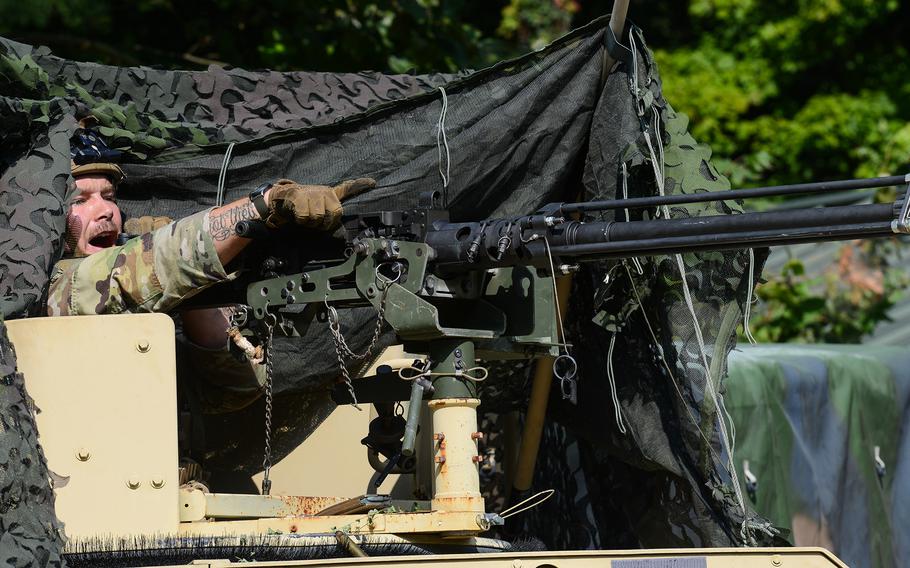
A Security Force Assistance Brigade soldier — known as an “advisor” — mans a .50-caliber machine gun during a pre-deployment training exercise Aug. 23, 2023, at Muscatatuck Training Center in Indiana. (Corey Dickstein/Stars and Stripes)
The first-of-its-kind training event, Operation Combined Victory was built to stress the abilities of SFAB soldiers, who undergo specialty training to advise and assist conventional military forces of partner and ally nations. During the training, the troops operate under stressful combat scenarios and test their communications abilities across large distances, said Lt. Col. Mike Ziegelhofer, an armor officer who took command of 3rd Squadron, 3rd SFAB in July. Ziegelhofer, a U.S. Military Academy at West Point, N.Y., graduate with multiple combat tours in Iraq and Afghanistan, will lead his squadron on the upcoming six-month tour, which will see his advisors replace SFAB soldiers now deployed in Jordan, Kuwait, Saudi Arabia and the United Arab Emirates.
From inside a makeshift tactical operations center at Muscatatuck Training Center last week, Ziegelhofer said Operation Combined Victory should prove his squadron has prepared to take over advising operations in much of the Middle East, where 3rd SFAB has maintained a permanent presence since 2021. The Pentagon views those partnerships as a critical tool to keep partner forces close, especially amid a worldwide competition for influence between the United States and other powers such as China and Russia.
“We’re really building trust as a team by putting ourselves through these tough training scenarios,” Ziegelhofer said an interview during the training rotation. “Advisors [from the SFABs] are such small teams that when we deploy out to conduct these different missions everybody’s got to fill two and three and four roles. So, we’re out here building trust in each other, not just to be able to fulfill our own [individual] responsibilities, but to backfill each other in their roles and really expand out the knowledge that each team member brings to the fight.”
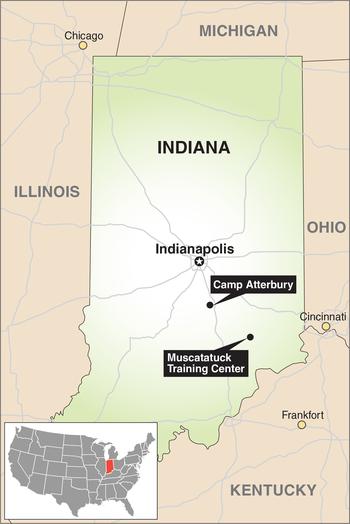
(Noga Ami-rav/Stars and Stripes)
Operation Combined Victory
In Operation Combined Victory’s scenario, SFAB advisors initially deployed for a peacetime mission to aid a partner force in conducting a combat training center-style rotation, like those that Army forces would see at the National Training Center at Fort Irwin, Calif., or the Joint Readiness Training Center at Fort Johnson, formerly Fort Polk, in Louisiana.
That mission would be typical for any of the SFABs in any of the 50 countries where advisor teams now have a permanent presence, Ziegelhofer said. When his 3rd Squadron, 3rd SFAB deploys in the coming weeks, it will conduct similar training for its partner forces in several countries in the Middle East.
But in the exercise, the mission suddenly changes. While SFAB soldiers are training partner forces, a neighboring nation invades the country where the SFAB advisors are working — launching a war in a U.S.-partner nation with American troops present. The SFAB soldiers are forced to move from training partner forces into advising them to fight off invaders — a modern military with skills and equipment like the U.S. Army.
“Our team is built for conflict,” Ziegelhofer said of the scenario, the kind of incident that could lead to the United States sending in a larger combat force to defend its ally or partner from the attack. “As the SFAB, we’re already plugged in, we have the same systems that the team coming in has, and so we’re the guys who can provide that immediate operability and that liaise effort to say, ‘Here’s what the partner force is up to, here’s what they expect, and here’s what they’re kind of counting on us for.’ ”
In the training event, advisor teams live side-by-side with their partner forces at Muscatatuck and nearby Camp Atterbury, another Indiana National Guard installation about 40 miles northwest of Muscatatuck. The operation marks the first time an SFAB unit has trained at Muscatatuck.
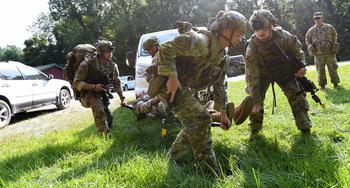
Security Force Assistance Brigade soldiers — known as “advisors” — help a soldier with a simulated injury during a pre-deployment training exercise Aug. 23, 2023, at Muscatatuck Training Center in Indiana. (Corey Dickstein/Stars and Stripes)
The remote Army training center run by the Indiana National Guard spans 1,000 acres near southern Indiana’s Butlerville. Largely hidden by dense corn fields that line state highways for miles, the training complex features an “abandoned city,” with nearly 200 buildings, many left over from its time as a mental institution. Those buildings include a former hospital, a jail, a radio station, a school, two massive rubble piles and a neighborhood of buildings partially submerged in water. Beneath the city lies more than a mile of tunnels that connect most of the 1930s- and 1940s-era buildings. Muscatatuck also boasts 900 meters of manmade caves dug beneath a hill, officials at the post said. The unique mix of buildings has made Muscatatuck a popular training location in recent years, especially among some the military’s most elite units who can tailor training at the post to rehearse for specific missions, officials there said.
For the SFABs, the complex gave soldiers an expansive training area where planners could tailor their pre-deployment exercise to simulate conditions that they might see in the countries with which they partner. In Operation Combined Victory, SFAB soldiers found themselves in combat in wooded areas and Muscatatuck’s urban environment fending off drone attacks and enemy forces, officials said.
Army 1st Sgt. Andrew MacVey described Muscatatuck’s training as “peerless,” especially because of the digital environment that the Army has provided for troops at Muscatatuck. The Army built a closed cellular network with its own social media platforms to test soldiers’ abilities to respond to information warfare while conducting training exercises.
“We’re able to do things here that we could not do back home at Fort Cavazos,” said MacVey, who will deploy to Saudi Arabia with 3rd Squadron, 3rd SFAB. “The partnership with the role players playing our partners — it adds some real-world scenario effects, and I think it’s really stressing our systems. Our troops are learning a lot and quickly.”
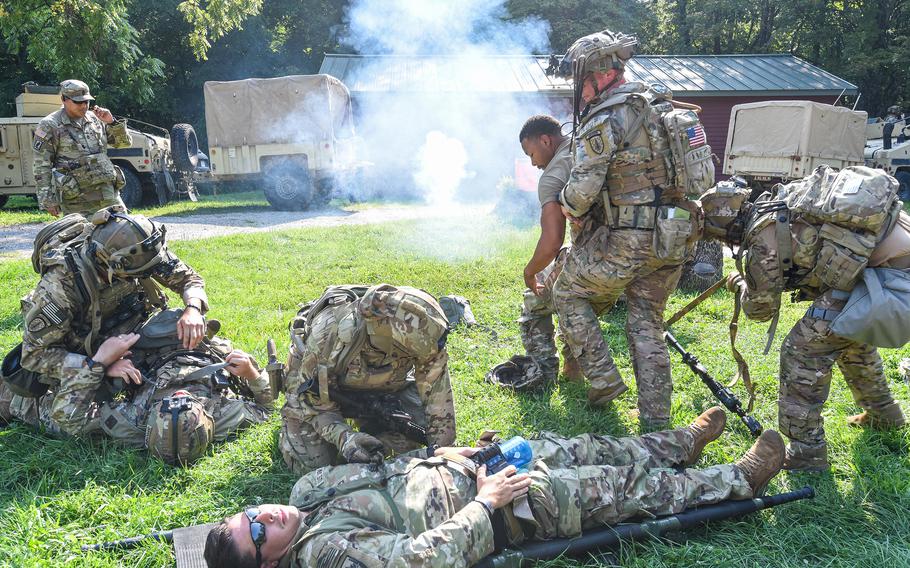
Security Force Assistance Brigade soldiers — known as “advisors” — help soldiers with a simulated injuries as indirect fire strikes in the background during a pre-deployment training exercise Aug. 23, 2023, at Muscatatuck Training Center in Indiana. (Corey Dickstein/Stars and Stripes)
The brigades
The SFABs were initially designed in 2017 to take deployment pressure off the Army’s brigade combat teams, which had for years been rotated in and out of war zones in Afghanistan and Iraq to train those nations’ forces to fight the wars there. With a growing Chinese military and increased Russian aggression during the last decade, top U.S. Army generals saw the need for its combat brigades to refocus their efforts on the kind of large-scale operations that American troops would need to master to fight a near-peer adversary.
Gen. Mark Milley, the Army’s top general before becoming chairman of the Joint Chiefs of Staff, pitched the SFABS as purpose-built to conduct the kind of training, advising and assisting operations that brigade combat teams had been doing in Iraq and Afghanistan. This would allow the service’s combat brigades — the backbone of the U.S. military’s conventional land power — to build combat readiness for a major war.
The five active-duty SFABs have been aligned to the Pentagon’s geographic combatant commands to provide a constant presence of small teams to partner nations. The 1st SFAB from Fort Moore, Ga., is committed to U.S. Southern Command; the 2nd SFAB from Fort Liberty, N.C., to U.S. Africa Command; the 3rd SFAB is aligned to U.S. Central Command; the 4th SFAB from Fort Carson, Colo., is aligned to U.S. European Command; and the 5th SFAB from Joint Base Lewis-McChord, Wash., to the Indo-Pacific Command. The 6th SFAB, the National Guard’s 54th SFAB, augments the active-duty SFABs with additional forces when needed.
The point is to maintain consistent presence in key locations where no matter which SFAB soldiers are deployed, they are offering the same kind of advice and training oversight to partner forces, Ziegelhofer said.
“We like to talk about our value proposition as persistent presence in partnership,” he said. “We’re just always there. Our brigade is the persistent presence because it’s not the same faces every day for 18 months, but it’s the same uniform, the same patch, same hat, the same unit, the same training, same equipment, same knowledge that are coming in.”
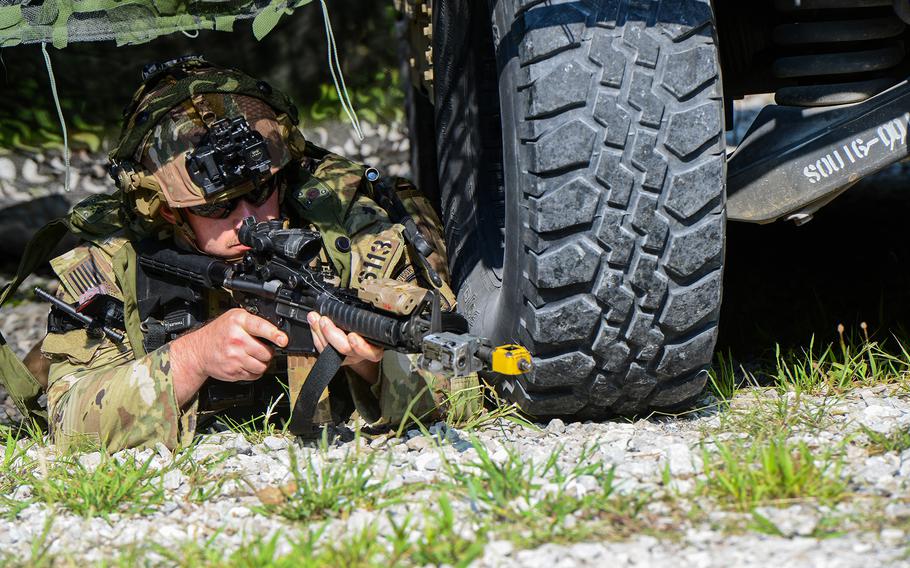
A Security Force Assistance Brigade soldier — known as an “advisor “— reacts to an enemy attack during a pre-deployment training exercise Aug. 23, 2023, at Muscatatuck Training Center in Indiana. (Corey Dickstein/Stars and Stripes)
The concept has proved popular among nations seeking to work with the United States. There are not enough SFAB teams to meet the demand among allied and partner nations, said Master Sgt. Adrian Patoka, a spokesman for the Army’s Security Force Assistance Command, which is headquartered at Fort Liberty, N.C., formerly Fort Bragg, and oversees the Security Force Assistance Brigades.
The SFABs are built from volunteer officers and noncommissioned officers who can only join the unit after completing the specialty advisory training course at Fort Moore, the former Fort Benning, which teaches them advanced skills in combat first aid, language and leadership.
Units are small. An SFAB brigade consists of only some 800 soldiers — all officers and noncommissioned officers — and the advisor teams that embed into partner forces are typically 12 soldiers led by a captain.
MacVey will soon deploy with a unit that size to Saudi Arabia. The first sergeant, an Iraq war veteran who long served as a cavalry scout before joining the SFAB, said he was attracted to the mission for the opportunity to work in small teams.
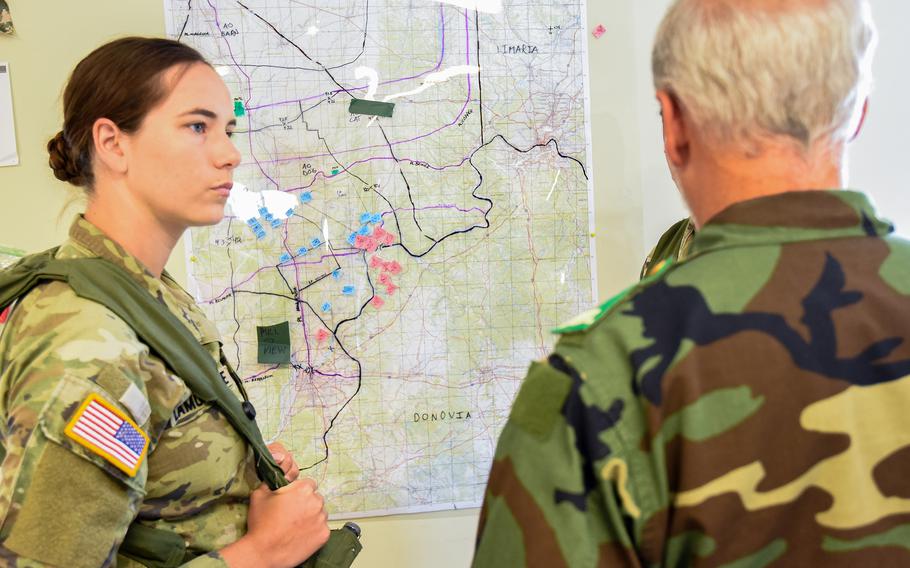
Staff Sgt. Emily Lamontagne, who serves in intelligence with the National Guard’s 54th Security Force Assistance Brigade, briefs a role player playing a partner force commander on the ongoing battle during a pre-deployment training exercise Aug. 23, 2023, at Muscatatuck Training Center in Indiana. Lamontagne’s unit will attach to the 1st Security Force Assistance Brigade this fall to deploy to Colombia. (Corey Dickstein/Stars and Stripes)
“What’s unique about being in an SFAB is you deploy with a small team, you’re self-sustaining, self-sufficient, and you’re offered a lot of freedom and latitude to go out and find your own work with our partners,” MacVey said. “I’ve gone through a lot of training with SFAB that has really expanded my knowledge base, that I wouldn’t have ever been exposed to in the regular Army. And, now, we’ll take that and teach and coach and advise our [Saudi] partners.”
Ziegelhofer, who is commanding an Army battalion for a second time, said he has been awed by his SFAB troops. He pointed to the medical expertise that he saw among the SFAB troops, such as Corday, who during Operation Combined Victory are working on providing prolonged care to wounded troops because SFAB troops might not be able to rely on traditional medical infrastructure in the areas where they deploy.
During the training event, medics simulated blood donations using blood collected from soldiers on their teams to keep wounded advisors alive.
“You’ve got to rely on yourself, and so I for the first time got to see our medical teams in action to provide prolonged care to a patient with a [simulated] gunshot wound,” the squadron commander said. “At a typical Army battalion, you’re maybe able to provide that kind of care for a couple of hours, these guys just did it for 18 hours.”
He said those advanced abilities built into the SFABs breed trust in the unit’s advisors during training such as Operation Combined Victory.
“You’re going to send these guys in small teams out into distributed places, so knowing that they have a medical team within them that’s going to be able to provide the level of care after watching them do it — having been one of the guys here sitting as they’re taking blood — talk about building trust on the team,” Ziegelhofer said. “That’s a good way to do it. It is absolutely eye-opening.”